Half-Empty Art Journals I Should Fill Up
Last month, I went through my art supplies and wrote a post about the supplies I shouldn’t use anymore. After the post, I gave most of those useless-to-me supplies away. Now I have reviewed my art journals and have come to the conclusion that I have too many half-empty ones. I should fill these up and at the same time, end one era in my artistic journey.

I don’t mean I shouldn’t have any art journals or sketchbooks anymore, but I think I could do well with only one or two. I have grown my skills by drawing a lot, but now I feel I am more of a painter. Most of my creative energy nowadays goes into painting, and I mostly make either watercolor or canvas paintings. So, the books don’t serve me as much as they have in the early years.
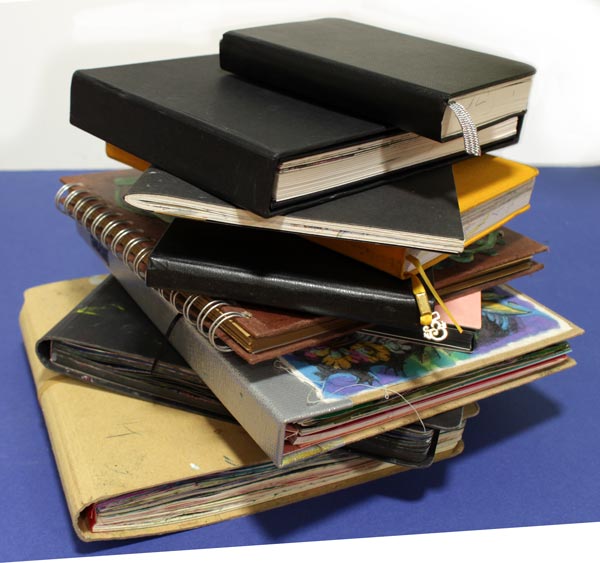
Ten of my art journals are half-empty. I don’t think it’s realistic to fill them in a short time. On the other hand, I have small pieces and hand-drawn motifs that I could attach to the pages and make collage art. Anyway, I wanted to share my inventory. Time will tell how quickly these will be filled!
Art Journal #1 – Smash Book
Who remembers the Smash Books by K&Company? I have several, but only one of them is unfinished. This one has the best cover as I have attached my fabric drawing to it.

This journal has all kinds of pages, but I want to show you the spread that has slow stitching. I have just glued the hand-embroidered fabrics on the pages.
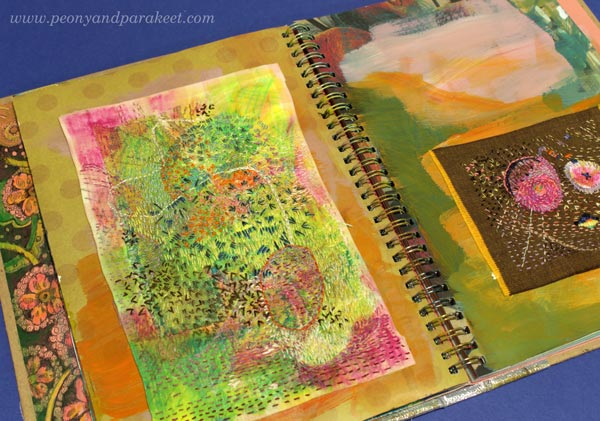
Maybe I could continue this journal with the fabric theme and search for other hand-embroidered pieces from my needlework stash?
Art Journal #2 – Accordion Book
This art journal is really fancy. It’s an accordion book with a separate casing. The paper holds watercolor well but it’s smooth enough for drawing and coloring too. I have got this as a gift from a student of my courses.
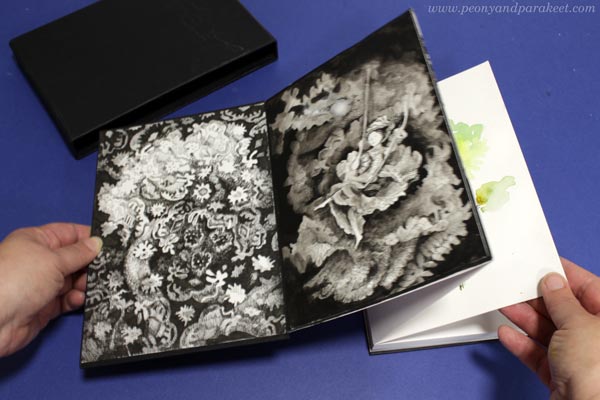
This journal has quite a many filled pages, but as it’s an accordion book, I could fill the rest of the pages with a watercolor painting that would continue from one page to another.
Art Journal #3 – Spiral Bound Sketchbook
I shared the process of making the collage cover in this blog post from 2020.

When I start making a new course, I often buy a new sketchbook, and that’s what happened here too. This book has mostly portrait drawings. They were drawn when practicing and gathering ideas for the course Innovative Portraits. Some portraits are very abstract like the one below.
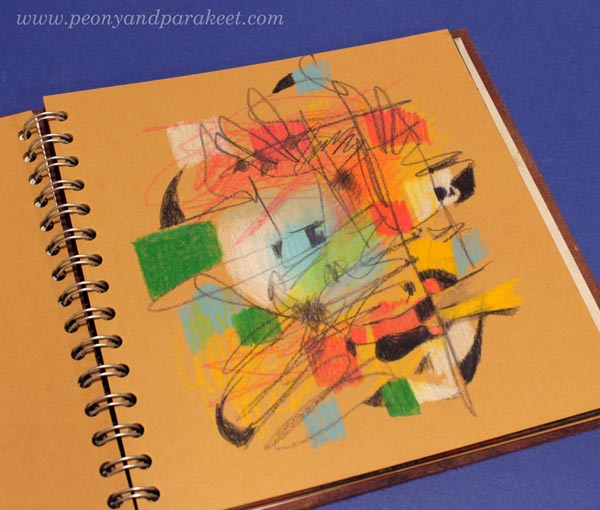
This book has still many empty pages. Here, I could gather other face drawings that I have made over the years. I think that at some point, every artist wants to draw faces.
Art Journal #4 – Small Sketchbook
Most of my art journals are filled with colorful art and contain fairly little writing or black-and-white sketches. This little sketchbook has some interesting ideas and it’s more like a notebook about art-making.
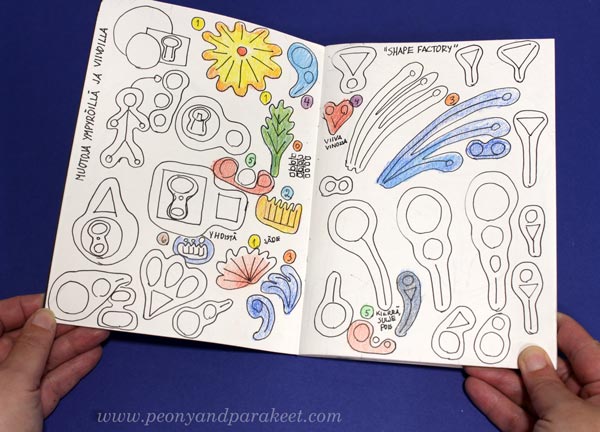
This sketchbook is almost full, and could be filled very quickly with the ideas for the upcoming paintings and courses.
Art Journal #5 – Colored Pencil Diary
This journal is an Archer & Olive Notebook that I call my colored pencil diary. I have filled many pages already. For example, see the blog post about coloring without limits!

My favorite part of the book is the chapter that has fun plant-themed pages. I made them for the course Fun Botanicum.

Even if this journal has many filled pages, it still has a lot of blank pages. However, I feel the journal is ready to be called finished. Should I remove the blank pages? What do you suggest?
Art Journal #6 – Bullet Journal
I love bullet journals but don’t usually draw in them. However, in 2018-2019 I bought a dot-grid journal just for small drawings. These became inspiration pieces for the course Animal Inkdom.

The drawings leave room for writing, and there are many empty pages left. I think I should remove this journal from my art journal shelf and use it for bullet journaling once my current bullet journal gets full.
Art Journal # 7 – Tiny Sketchbook
My smallest art journal is still quite empty. It has some lovely drawings, though!

Should I continue this, or just take out the pages and glue them on another art journal? When I carry a journal with me, I prefer a bigger one.
Art Journal #8 – Dylusions Creative Journal Square with Black Pages
Dylusions Creative Journals are sturdy and their paper is quite thick. I like to practice painting by filling their page. Black is a nice background, especially when I use leftover paints from the palette.
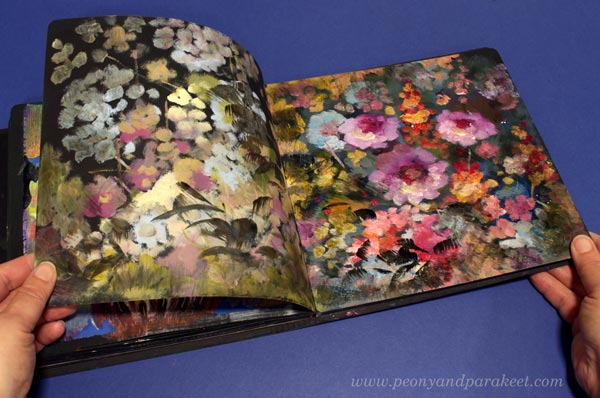
This is the kind of journal I still want and need. It will get filled over the years and there’s no pressure to do it right away.
Art Journal #9 – Moleskine Watercolor Notebook
Moleskine watercolor notebook is a small journal, but it has lovely panorama spreads and nice paper. See this blog post for more inspiration!
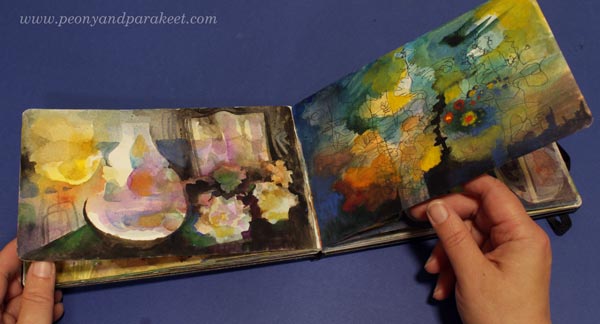
I am going to continue this one, for sure!
Art Journal #10 – Dylusions Creative Journal Square with Cream Pages
Dylusions Creative Journal with cream-colored pages is my favorite art journal. This journal works well with colored pencils, for example, see this drawing tutorial of Vermeer Girl!
The inside cover is colored freely with felt-tipped pens. I used thin marker paper for the drawing and then glued the paper on the cover.
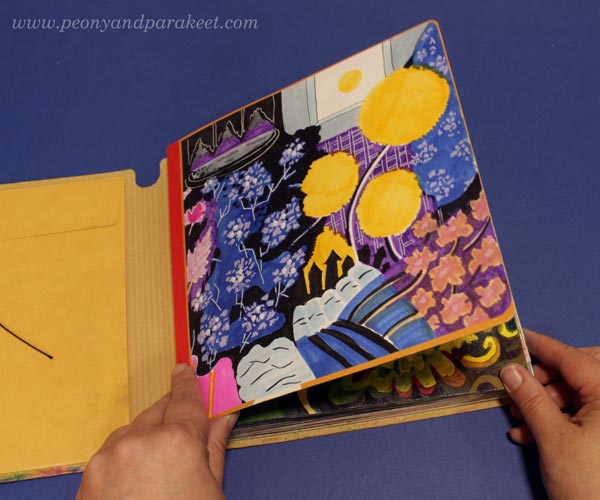
I started this journal about five years ago, and have almost filled it. But I like to keep working on the older pages, making them more beautiful. Like with the black journal, leftover paints find their way here.
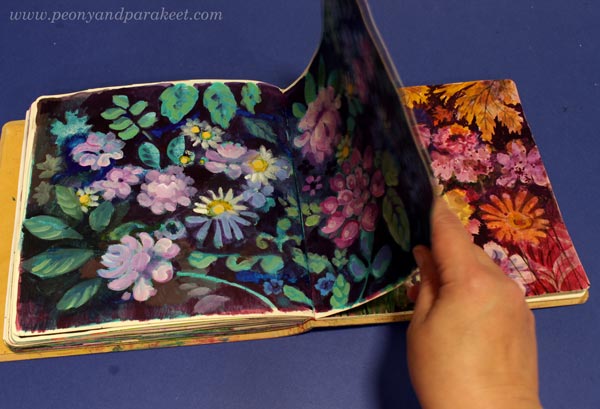
The paper holds water fairly well, and I use watercolors, acrylics, and oils there. I only wish that the paper would be bright white, not cream-colored. When the journal is full, I will record a flip-through video of it.
Half-Empty Art Journals – Question!
I have a shelf that has many full art journals. I have now put the half-empty ones on the right, so that they don’t get mixed with the full ones.
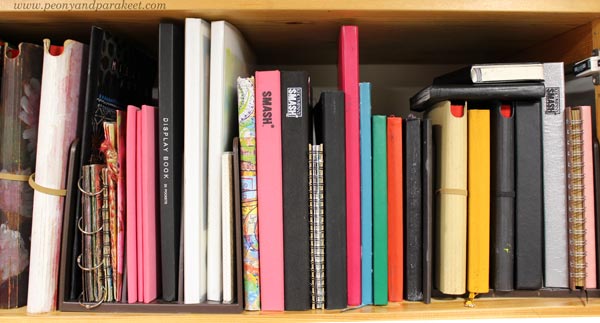
How many half-empty art journals do you have? Leave a comment!
Wild Garden – Paint with Me!
In the upcoming course Wild Garden we will paint flowers freely, intuitively, and expressively in watercolor. Watch the video and sign up now!
Wild Garden will begin on September 22, 2025. Sign up here!
Art On the Wall – Displaying Canvas Paintings
Our home is full of art. Almost all my canvas paintings are displayed on the walls. The arrangements change when old ones are sold and new ones are born. In this blog post, I show some of the paintings and how they are displayed at the moment.
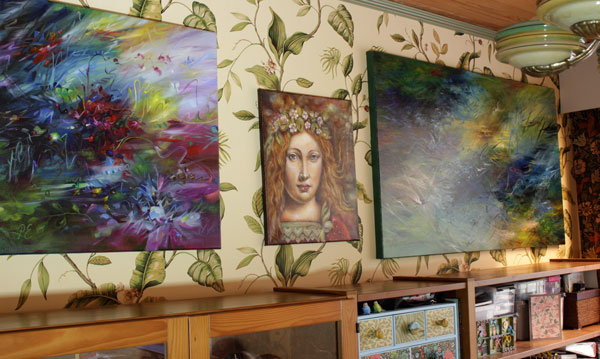
When using stretched canvases, framing is not necessary. I hope this inspires you to create some canvas art. Check out my acrylic painting course Floral Freedom and see more of my paintings at paivieerola.com/gallery!
In the Gallery Corner
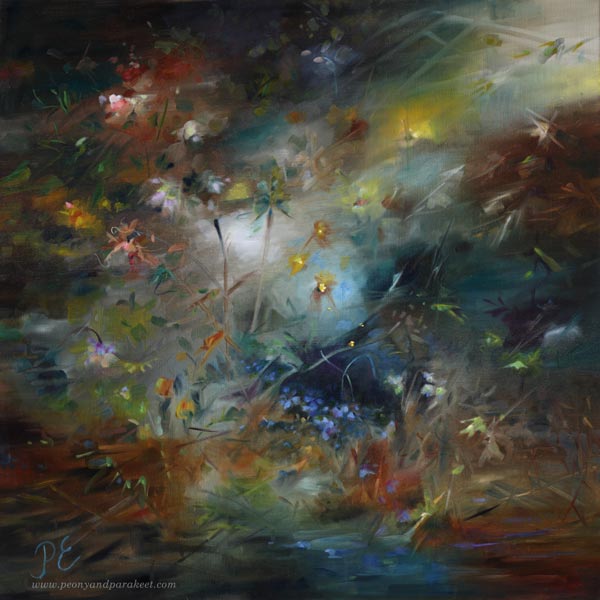
Our library room is on the darker side of our house, but I think that the lack of daylight and a heavy atmosphere goes well with the books and nostalgic-style paintings.

Displaying different sizes of canvas paintings on the same wall looks great but needs planning. I made a plan in Photoshop first, and then we hung them all at once.
Above the Aquarium
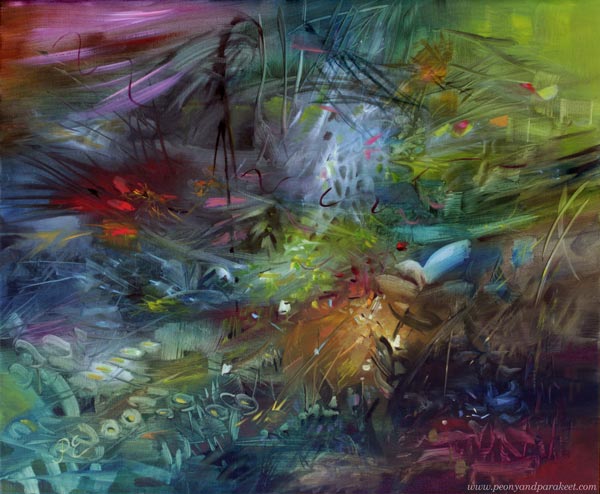
People often say that all my canvas paintings express the underwater world. That hasn’t been intentional because I am actually afraid of deep waters. But my husband has had aquariums for decades, and they must have affected my art.
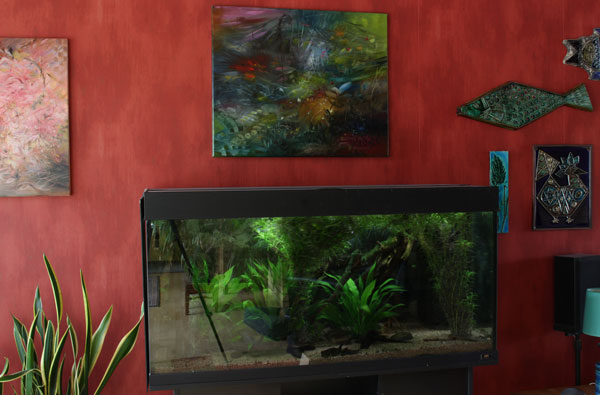
The painting continues the aquarium view. And it was not planned at all!
Best Lit
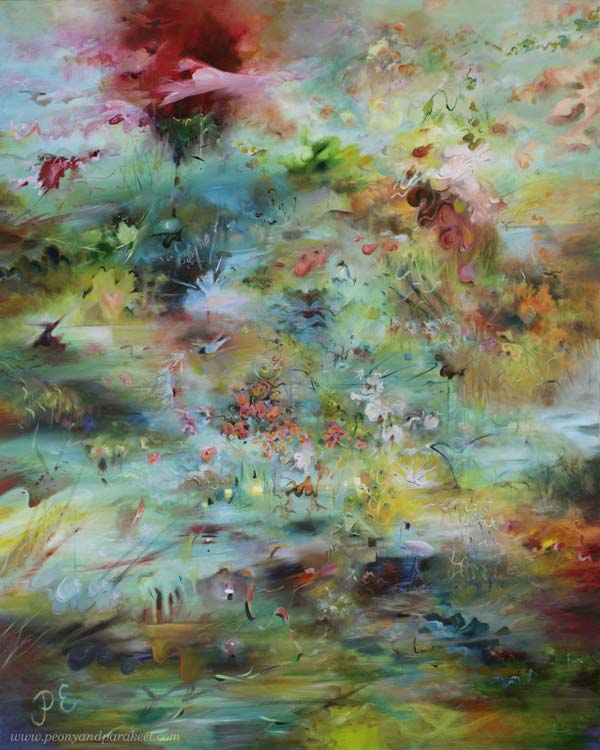
Our dining area has special lighting for a big painting – LED strips in two directions that have adjustable color and intensity.
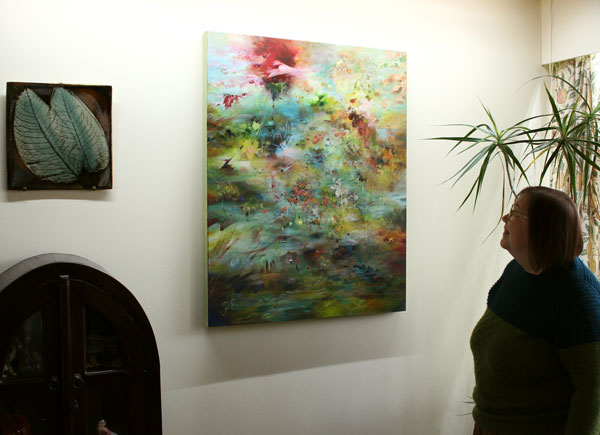
The colors of any painting are highly affected by the amount and color of light.
When I Wake Up
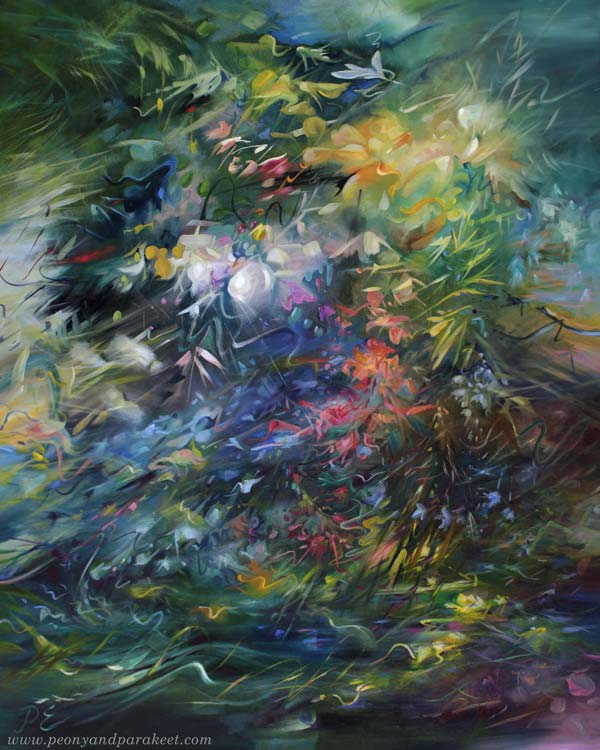
The bedroom is our darkest room, but every morning when I wake up, I look at the wall that is filled with my paintings.
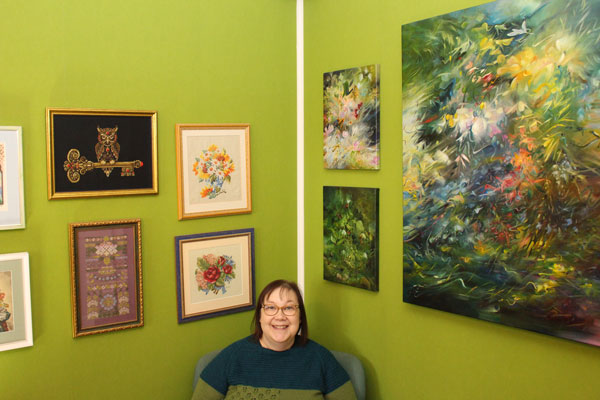
There is also a collection of my cross-stitch projects. Stitching is just a hobby but I like the combination.
In the Hallway Gallery
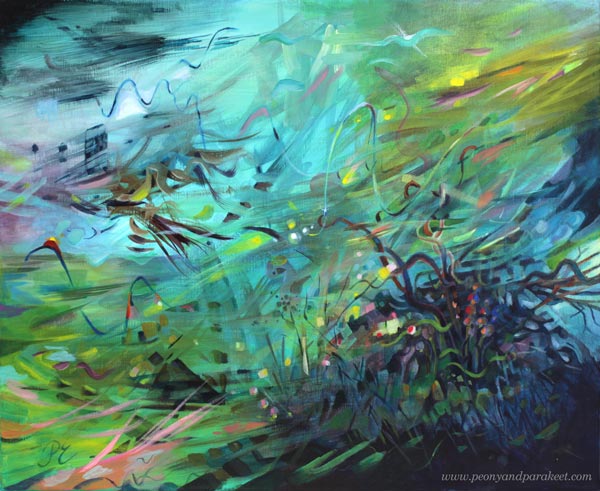
I love our yellow hallway and how the color unifies a mixed collection of paintings. Displaying canvas paintings can be this easy!
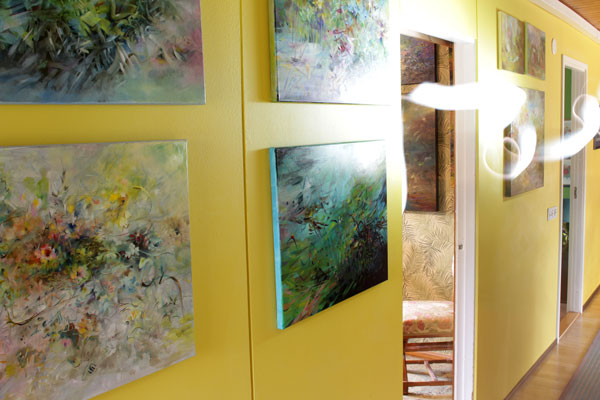
This narrow hallway was super boring before we painted it and added art on the walls.
Entrance Art
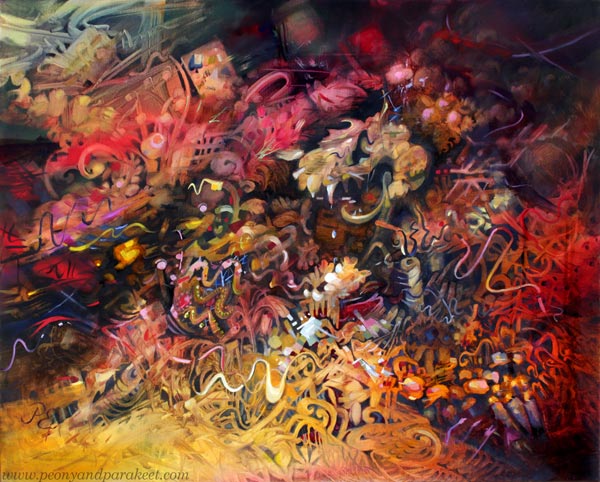
Our house has a space right after the entrance where I often change a painting to one that feels current. I also decorate the top of the sideboard cabinet that’s under the painting. Now it’s time for some darker art.
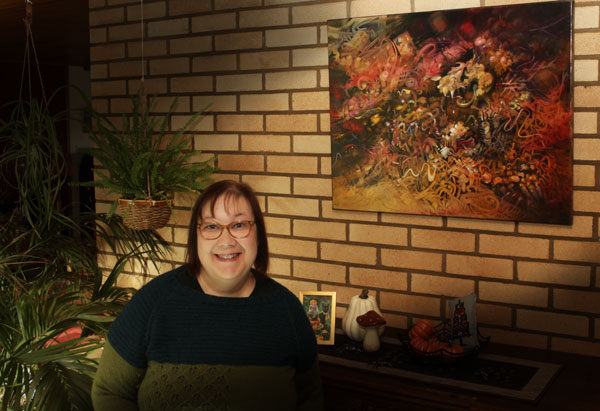
Happy Halloween!
Weekly Art – Creating Regularly in Any Mood
This week, I talk about making weekly art and the feelings behind creating regularly.

I feel that although artists talk a lot about techniques and creative process, something gets left out. It’s a time perspective. I don’t mean how much time it takes to make one piece, but what it’s like to make art week after week. If you create art, you will surely recognize this: sometimes you feel excited, sometimes you don’t. People’s moods vary and you can’t always choose the best day.
Not the Ideal Mood
I felt nervous when I started doing this watercolor. The best part of the morning was already over and I was splashing color very fast. My weekly art session had a messy start.

I found an unopened bottle of granulating medium in my stash and thought it might speed things up.

But I found the medium a useless acquisition. Some of the pigments are naturally spreadable and the spray bottle works better for them. All this took time, and my nervousness was still present and there was a new feeling too: self-doubt.
Not Feeling Confident
When you make art week after week, success is based on self-confidence more than mood. It’s easier to be confident at the beginning than later.

I usually paint with intuition and don’t use any models, so I often end up feeling hopeless. All I can say then is something like: “Keep going!” with a fake smile, and I don’t know if that helps at all.
Different Mood – Different Ideas
But art doesn’t put one mood above the other. Different mood brings different ideas. For example, if I am feeling nervous, there is an opportunity to be less conventional and express something that I would not otherwise come to mind.

The idea of this painting culminated in the Finnish expression “alavilla mailla hallanvaara.” It means “the danger of frost in the lowlands” in English, but the beauty of the statement is not in its content, but in how it sounds in Finnish. While painting, I began to think about those lowlands that suffer from rain and cold. Similarly, as painters paint week after week, flowers bloom constantly there, also in bad weather.

For me, in art, it’s not important in which mood it’s started, but that the end result contains both a trigger and a solution. Here, wind and rain bend the grass and break flower petals, but at the same time they make room for light.
Who Are You Creating Art For?
Within time, the mood evens out and focus is on the finishing. Then I also change who I think as a recipient.
I often start the weekly art by saying that “this piece is for me,” but when I finish I try to reach “for us.” There “we” includes all who like my art, both old and new friends in art. I don’t want to make art only “for you”, because then I lose myself while doing it, and not ” for them”, because it’s hopeless to hope that maybe someone would like the work even if we wouldn’t.

So, weekly, this happens again: the wrong moment, the wrong mood, the choice of brushes and colors, calming down, “I’m just doing it for myself”, uncertainty, slowly emerging ideas, concentration, triggers and solutions, happiness, and a feeling of gratitude that I can do this again for us.
Do you too create art regularly?
Pleasures of Watercolor Painting
This week is about watercolor painting and the pleasures that can be found there!

Getting Inspiration
Now I’ve been busy with a lot of different things – a new big art project, the new course Freely Grown, commissioned work, etc. Despite that, I stole some time and went to look at old paintings online – skillfully painted portraits of women in fancy dresses. They always make me want to paint, even though I prefer to paint plants and flowers instead of beauties.
Look at this painting of the Duchess Alexandra Iosifovna, painted by Franz Xaver Winterhalter in 1859!

A detail – only a part of the painting is in this image.
The colors, the brilliant brush strokes, and all the delicate and decorative details are so inspiring!
I used to think that inspirational images must be the same as what I want to paint next. So, if I wanted to paint flowers, then I would only look at flower paintings. But nowadays, I love to be inspired by something different. Then the inspiration doesn’t limit me. It doesn’t depict what I should do and how, but sets an atmosphere that I want to follow.
Love for Good Watercolor Paper
After getting inspired, I opened the closet of my studio, as if secretly from myself, and tore a clean sheet from the watercolor paper pad.
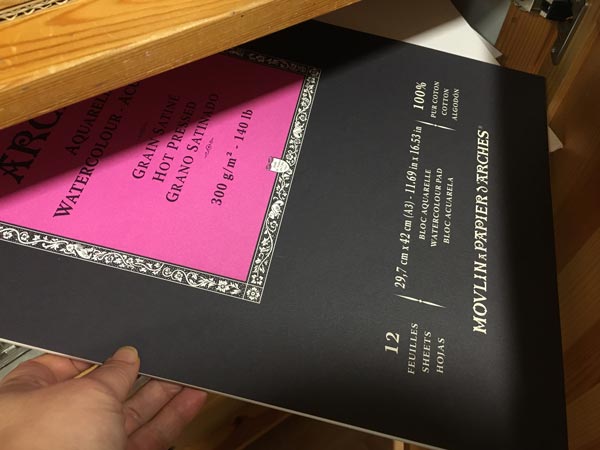
One hundred percent cotton, aah! So soft, thick, and ready to receive color. Good paper is expensive, but I paint better when I know in advance that I don’t want to waste a sheet.
Painting and Doing Other Stuff at the Same Time
When I steal time to paint, watercolors are an easy choice. Especially in the beginning, I can do one coat quickly and then let it dry for hours while I do other work.
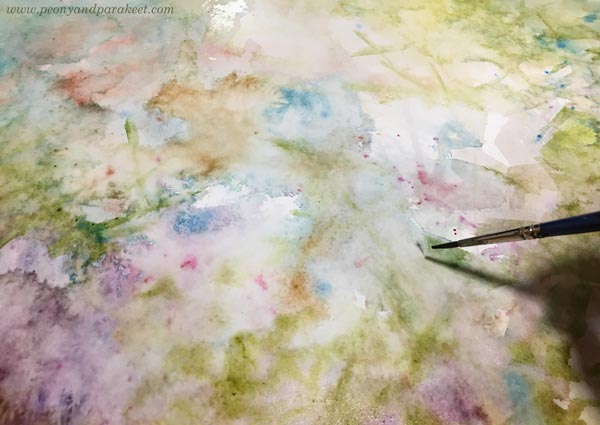
I can add details little by little, and the pauses often just clarify the idea of the subject of the painting. And when you paint slowly from light to dark, you can always fix it with the next layer.
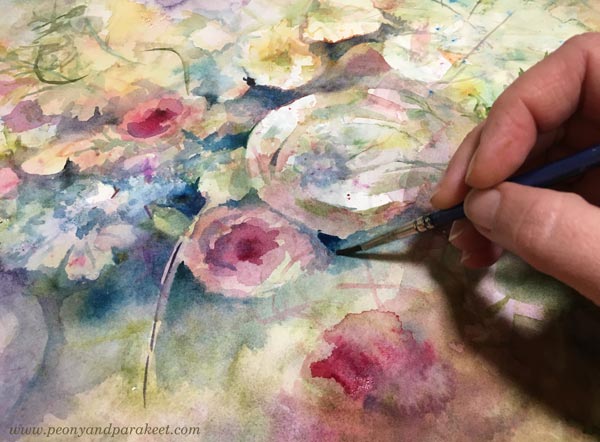
I often have my iPad nearby and listen and watch something at the same time while I paint.

Luxury Combined with Minimalism
When finishing, it’s pleasurable to take just a little color on the brush, and often near the pan, if it has spilled there. I also check the corners of the palette, where unused paint easily remains. When the color is activated on paper, even a small amount becomes a treasure and an experience!

I always buy good artist-quality watercolors one pan and one tube at a time and use them right up to the end. If I buy a tube, I squeeze a small amount into a pan to dry and this way, use the tube in small portions. I love this kind of union of luxury and minimalism – definitely one of the pleasures of watercolor painting to me!

Finally, I wash the brushes carefully. Washing with water is enough for most brushes, but I often use soap to make sure that all the color has come off. With clean brushes, it’s nice to start a new painting again when I find time.
From Detail to Detail
Here are some pictures of the details.

I like to paint a lot of subtle details, and I love the warmth that yellow has.

Signing the piece before the final finishing touches makes sure that the signature fits with the rest of the composition.

I hope this blog post inspired you to pick watercolors and paint freely!
P.S. Freely Grown – You can still hop in!
